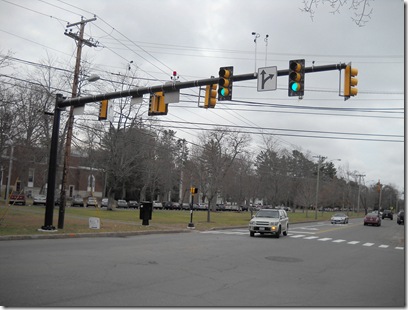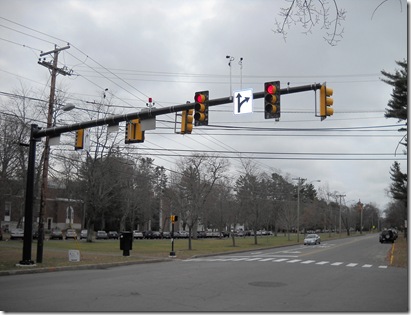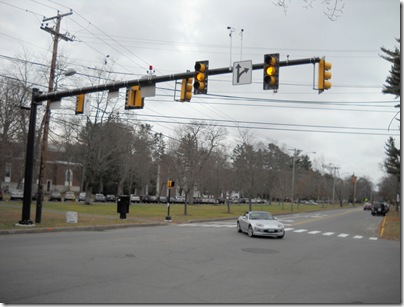‘Twas the month before Christmas,
when all through the house,
not a creature was stirring,
not even a mouse.
The Springers were nestled all snug on our laps,
happy to warm us for long winter naps.
Mama in her kerchief, and I in my cap,
laid back the recliners, clickety-snap.
Then out on the town,
there arose such a clatter,
I sprang from my sleep
to see what was the matter.
And what to my wondering eyes should appear,
but workers and trucks and all sorts of gear.
There on the mall with leaves all around,
the State was a-planting a grand Tannenbaum.
The glow of the newly hung bright colored lights,
would surely be warming our cold winter nights.
When the workers were done I heard them recite,
Merry Christmas to all, and to all a good light.
Such is Side’s way of honoring the glorious new traffic signal at McKeen and Maine, which we suggest, has most of the attributes of a magnificent municipal Christmas Tree. As passé and politically incorrect as such a thing might be. (Read, for example, of Portland’s wimpy PC behavior here.)
Why just look: alternating red and green lights are visible from all directions. 24 hours a day, 7 days a week, 365 days a year (except in leap year, we suspect.)
And a perfect little red “tree-topper” as well! Look hard in the photos below, and you’ll see it. Or check it out when you drive by.
For those offended by the ‘divisiveness’ of this imagined Judeo-Christian display, amber lights alternate as well in a gesture of community inclusiveness.
By now we trust you’re making the connection between Brunswick’s reality and Side’s parallel world. But in case you aren’t, here’s photographic evidence:
First, the green lights:
Then the red lights:
And last, the secular, multi-cultural amber lights:
You can clearly see that the huge “tree” the State planted has six distinct light “arrays.” Curiously, this intersection was, until a few weeks ago, ‘controlled’ with a single stop sign.
Coming from our background in the “bloated defense industry” as it’s often called, we’ve been $400 hammered over the years about $800 toilet seats, and we’re more than willing and able to explain how our benevolent government can make such trivial commodities cost so much.
Still, we couldn’t help but wonder how much this wondrous new addition to Brunswick’s village atmosphere cost. So we set out to find the answer. Don’t you go fretting none over it, though, because as we often hear, ‘it didn’t cost the town anything,’ because the state paid for it.
We suppose if you checked with the state, they might say ‘it didn’t cost the state anything, because the feds paid for it.’ See? There really is a Santa Claus after all, or more correctly, several Santa Clauses.
Well anyway, we have hard data showing the state hired a contractor for just shy of $79,000 to build the “Tannenbaum” and fully decorate it. The detailed breakdown, on top of everything else, shows 25 hours of “flagger” labor.
We imagine you’re like us; you’ve always wondered what they pay those folks to hold a sign and smoke and drink soda. On this job, the flagger is billed to the state at…are you ready…$48 an hour!! That rate surely includes profit and overhead, which includes things like benefits, etc.
In the ‘bloated defense industry,’ with immense overhead for plant security, classified document control, typing pools, purchasing departments, and other loaders than you could guess, $48 an hour would translate back to 19-20 dollars an hour in actual wages. We sure as hell hope that overhead and profit for flaggers is less than what it was for defense workers, which means the flagger must be earning north of $800 a week for 40 hours a week, unless middle-men are getting rich building signals.
That works out to around $42,000 a year, significantly more than the average Mainer’s income, and not too bad for twirling a stop sign on a pole at a construction site, with all the risk that entails. So you can file your curiosity away in the questions answered file.
Knowing full well that the contractor charge wouldn’t cover it all, we looked further. Without boring you with details, you can figure the bottom line cost at the Augusta level is in the $110,000 to $120,000 range. Which makes my original SWAG of around $200,000 a bit, well, bloated.
On the other hand, $120,000 ain’t exactly chicken gonads, either. But there does appear to be good reason for the costs to be so high compared to the prior stop sign.
<parody>
When we visited the “tannenbaum” to take the photos, we noticed something special about those four pedestrian crossing sign posts, the ones that speak the words “McKeen Street.”
To make sure our Bowdoin students feel deeply appreciated by the town, each post has a 9” all weather, full color display screen with a touch sensitive keyboard. This is so the students don’t get bored or unsettled while waiting for a light to change, and allows them to Twitter, Facebook, or text while standing still for a minute or so.
There’s also a built in breathalyzer that checks to see if they’re sober enough to cross the street after dark.
We blew into it as a test, and it replied “hey dog breath, brushing your teeth more than once a month might be a good idea.”
</parody>
So; $400 hammers? $800 toilet seats? Bloated Defense Department?
I don’t think so Tim; a new champ is ready to claim the title.



No comments:
Post a Comment